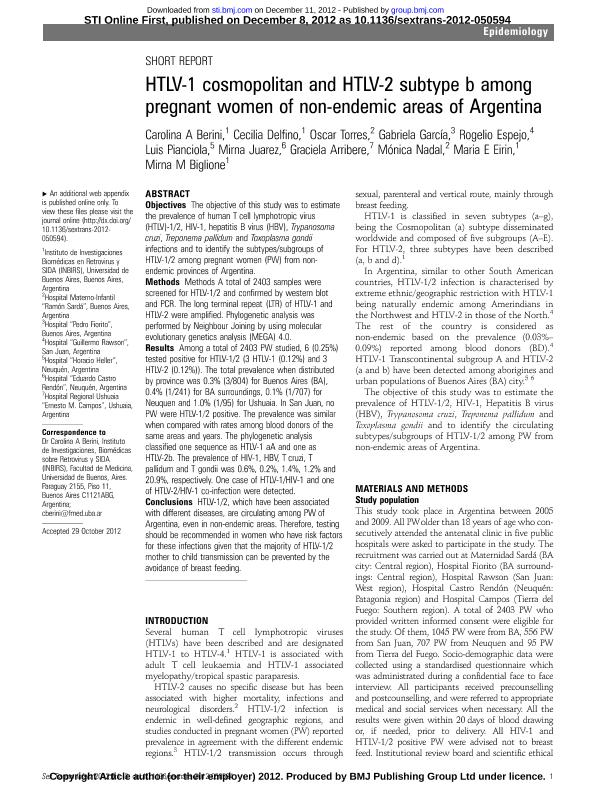Artículo
HTLV-1 cosmopolitan and HTLV-2 subtype b among pregnant women of non-endemic areas of Argentina
Berini, Carolina Andrea ; Delfino, Cecilia María
; Delfino, Cecilia María ; Torres, Oscar; García, Gabriela; Espejo, Rogelio; Pianciola, Luis; Juárez, Mirna; Arribere, Graciela; Nadal, Mónica
; Torres, Oscar; García, Gabriela; Espejo, Rogelio; Pianciola, Luis; Juárez, Mirna; Arribere, Graciela; Nadal, Mónica ; Eirin, Maria Emilia
; Eirin, Maria Emilia ; Biglione, Mirna Marcela
; Biglione, Mirna Marcela
 ; Delfino, Cecilia María
; Delfino, Cecilia María ; Torres, Oscar; García, Gabriela; Espejo, Rogelio; Pianciola, Luis; Juárez, Mirna; Arribere, Graciela; Nadal, Mónica
; Torres, Oscar; García, Gabriela; Espejo, Rogelio; Pianciola, Luis; Juárez, Mirna; Arribere, Graciela; Nadal, Mónica ; Eirin, Maria Emilia
; Eirin, Maria Emilia ; Biglione, Mirna Marcela
; Biglione, Mirna Marcela
Fecha de publicación:
10/2012
Editorial:
B M J Publishing Group
Revista:
Sexually Transmitted Infections
ISSN:
1368-4973
e-ISSN:
1472-3263
Idioma:
Inglés
Tipo de recurso:
Artículo publicado
Clasificación temática:
Resumen
OBJECTIVES: The objective of this study was to estimate the prevalence of human T cell lymphotropic virus (HTLV)-1/2, HIV-1, hepatitis B virus (HBV), Trypanosoma cruzi, Treponema pallidum and Toxoplasma gondii infections and to identify the subtypes/subgroups of HTLV-1/2 among pregnant women (PW) from non-endemic provinces of Argentina. METHODS: Methods A total of 2403 samples were screened for HTLV-1/2 and confirmed by western blot and PCR. The long terminal repeat (LTR) of HTLV-1 and HTLV-2 were amplified. Phylogenetic analysis was performed by Neighbour Joining by using molecular evolutionary genetics analysis (MEGA) 4.0. RESULTS: Among a total of 2403 PW studied, 6 (0.25%) tested positive for HTLV-1/2 (3 HTLV-1 (0.12%) and 3 HTLV-2 (0.12%)). The total prevalence when distributed by province was 0.3% (3/804) for Buenos Aires (BA), 0.4% (1/241) for BA surroundings, 0.1% (1/707) for Neuquen and 1.0% (1/95) for Ushuaia. In San Juan, no PW were HTLV-1/2 positive. The prevalence was similar when compared with rates among blood donors of the same areas and years. The phylogenetic analysis classified one sequence as HTLV-1 aA and one as HTLV-2b. The prevalence of HIV-1, HBV, T cruzi, T pallidum and T gondii was 0.6%, 0.2%, 1.4%, 1.2% and 20.9%, respectively. One case of HTLV-1/HIV-1 and one of HTLV-2/HIV-1 co-infection were detected. CONCLUSIONS: HTLV-1/2, which have been associated with different diseases, are circulating among PW of Argentina, even in non-endemic areas. Therefore, testing should be recommended in women who have risk factors for these infections given that the majority of HTLV-1/2 mother to child transmission can be prevented by the avoidance of breast feeding.
Palabras clave:
Htlv-1
,
Htlv-2
,
Pregnancy
,
Phylogeny
,
Molecular Epidemiology
,
Prevention
Archivos asociados
Licencia
Identificadores
Colecciones
Articulos(INBIRS)
Articulos de INSTITUTO DE INVESTIGACIONES BIOMEDICAS EN RETROVIRUS Y SIDA
Articulos de INSTITUTO DE INVESTIGACIONES BIOMEDICAS EN RETROVIRUS Y SIDA
Articulos(OCA HOUSSAY)
Articulos de OFICINA DE COORDINACION ADMINISTRATIVA HOUSSAY
Articulos de OFICINA DE COORDINACION ADMINISTRATIVA HOUSSAY
Articulos(SEDE CENTRAL)
Articulos de SEDE CENTRAL
Articulos de SEDE CENTRAL
Citación
Berini, Carolina Andrea; Delfino, Cecilia María; Torres, Oscar; García, Gabriela; Espejo, Rogelio; et al.; HTLV-1 cosmopolitan and HTLV-2 subtype b among pregnant women of non-endemic areas of Argentina; B M J Publishing Group; Sexually Transmitted Infections; 89; 4; 10-2012; 333-335
Compartir
Altmétricas



